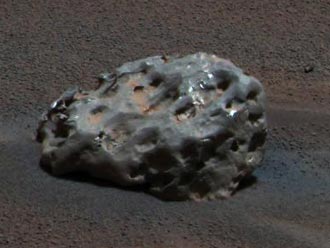
The rover ‘Opportunity’ has encountered six iron meteorites on Mars: a major enigma, suggests Joe McCall.
Geoscientist Online Special 31 August 2011
I first mentioned the encounter by the rover Opportunity of a large iron meteorite on Mars
1 (‘Heat Shield Rock’, but officially renamed ‘Meridium Planum’). I pointed out that because of the lack of friction to impede or break up such a large mass arriving on Mars, for such a mass to break up due to atmospheric friction in approach or brake and land gently on the cold Martian surface was quite impossible.
- Image: The first iron to be encountered by 'Opportunity'
I and others later discussed this
2 and suggested either it was product of a much earlier fall, when the atmosphere was warmer and wetter; or, it fell into a lake or sea then, and that drained away or evaporated; or that it hit a sand dune which absorbed the shock, was buried and re-excavated by deflation, leaving the meteorite exposed; or finally, that it could have survived cycles of building up and erosion of the plain, originally being buried but now being exposed.
I am not alone in remarking on the impossibility of such a large mass plunging through Mars’s thin atmosphere and hitting the ground and ‘sitting on it’. I quote
3: “A meteorite the size of a huge water melon on Mars is revealing new clues to the planet’s environment. It weighs at least half a ton, making it much too large to have plunged through Mars’s thin atmosphere and hit the ground without being obliterated on impact”, rover scientists said. “Either the atmosphere was thicker than expected at some time in the past……” Analysis showed it to be made of iron and nickel.
All this would be old hat now - but Opportunity has since encountered a multiplicity of similar irons since that first encounter.
An excellent poster in the aborted (because of nearby riots) 9 August poster session at the 74th Meteoritical Society Meeting at Greenwich
4 illustrated such masses and their location on the path of Opportunity. The first three new ones have been named, ‘Block Island’, ‘Shelter Island’ and ‘Mackinac Island’. The abstract reported that in fact six had been encountered in all. The rover spotted number five at the end of its 81-metre drive on 16 September 2009. And there is a sixth now being examined close up, and analysed
5. The fifth was named ‘Oiléan Ruaidh’ and the sixth ‘Ireland’.
The thrust of this abstract and poster was to describe the contrasting degrees of weathering due to limited oxidation and hydration, observed in cavities where troilite has been lost. The meteorites have been subjected to analysis by Pancam & Navcam Imaging, Alpha Particle X-Ray Spectrometer, Mössbauer Spectrometer and Microscopic Imager.
‘Block Island’ suggests partial burial and exposure and a large pit lined with delicate iron protrusions suggests inclusion removal by a gentle process
4. There is an expression of Widmanstätten pattern in four of the meteorites
4 – suggestive of differential abrasion - and spatially discontinuous iron oxide–rich coating elevated in Mn and Zn relative to the substrate, and large-scale cavernous weathering in two
4. Several of the meteorites have regmaglypts, suggesting that some areas altered more than others since their entry into the atmosphere of Mars. The possibility of acidic exposure to water, rather than wind abrasion, is discussed
4. Mechanical abrasion was also present
4. The coating is definitely the result of a post-fall process and is not a fusion crust
4.